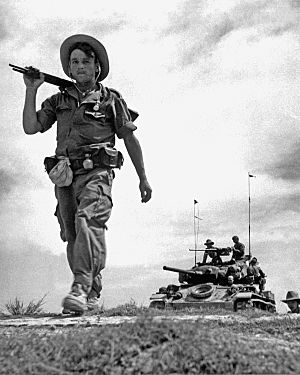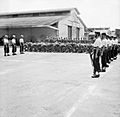First Indochina War facts for kids
Quick facts for kids First Indochina War |
|||||||||
|---|---|---|---|---|---|---|---|---|---|
| Part of the Indochina Wars of the Cold War | |||||||||
 A French Foreign Legion unit patrols in a communist controlled area. |
|||||||||
|
|||||||||
| Belligerents | |||||||||
|
|
||||||||
| Commanders and leaders | |||||||||
|
French Expeditionary Corps
Vietnamese National Army |
|||||||||
| Strength | |||||||||
| French Union: 190,000 Local Auxiliary: 55,000 State of Vietnam: 150,000 Total: ~400,000 |
125,000 Regulars, 75,000 Regional, 250,000 Popular Forces/Irregulars Total: 450,000 |
||||||||
| Casualties and losses | |||||||||
|
French Union: 75,581 dead, Total: ~560,000+ dead, wounded or captured |
Combined total: 300,000+ dead, 500,000+ wounded, 100,000+ captured Total: 900,000+ dead, wounded or captured |
||||||||
| 150,000+ civilians killed | |||||||||
The First Indochina War was a big conflict that happened in a part of Southeast Asia called French Indochina. It lasted from December 19, 1946, to August 1, 1954. People also called it the French Indochina War or the Anti-French War.
The war was fought between two main groups. One side was the French Union, led by France. They had help from the Vietnamese National Army, led by Emperor Bảo Đại. The other side was the Viet Minh, led by Ho Chi Minh and Võ Nguyên Giáp. Most of the fighting happened in Northern Vietnam, but it also spread to nearby countries like Laos and Cambodia.
Contents
What Was the First Indochina War?
The First Indochina War was a fight for independence. Before the war, Indochina was a colony of France. During World War II, Japan took control of the area. After Japan lost the war, France wanted to take back its control. However, the Vietnamese people, especially the Viet Minh, wanted their country to be free.
Why Did the War Start?
After World War II ended, France tried to re-establish its power in Indochina. But the Viet Minh, a group of Vietnamese nationalists and communists, wanted Vietnam to be an independent country. They had fought against the Japanese and now they fought against the French. This desire for independence led to the war.
How Was the War Fought?
At first, the war was a small fight in the countryside. The Viet Minh used guerrilla warfare, which means they used surprise attacks and hid in the jungle. They fought against the French forces who were trying to control the area.
A Changing War
In 1949, something important happened. Chinese communists reached the northern border of Vietnam. This meant the Viet Minh could get modern weapons and supplies from China and the Soviet Union. The war then changed from small attacks to bigger battles between two armies. The French also received help from the United States.
French Strategy and Challenges
The French tried a strategy where they would make the Viet Minh attack a strong base in a faraway place. This worked sometimes, like at the Battle of Na San. However, the French faced many problems. It was hard to build strong defenses because there wasn't enough concrete. Also, the land was very difficult, with no good roads. This meant tanks couldn't be used easily, and it was hard to get air support.
The "Dirty War"
In France, some people called the war the "dirty war" (la sale guerre). This was because many people, especially those on the political left, did not support it. The French government also decided not to send regular French soldiers from France to fight. Instead, they used soldiers from their colonies and the French Foreign Legion.
What Happened After the War?
The war ended on August 1, 1954. A meeting called the Geneva Conference took place on July 21, 1954. At this meeting, they decided to temporarily divide Vietnam into two parts.
- The North became the Democratic Republic of Vietnam, controlled by Ho Chi Minh and the Viet Minh.
- The South became the State of Vietnam, led by Emperor Bảo Đại.
This division was meant to be temporary. The idea was to prevent Ho Chi Minh from taking over the whole country right away.
The Path to Another War
A year later, in the South, Emperor Bảo Đại was removed from power by his prime minister, Ngô Đình Diệm. Diem then created the Republic of Vietnam. The Geneva Conference had suggested that elections should be held across all of Vietnam in 1956 to unite the country. However, Diem refused to hold these elections. This disagreement eventually led to another war breaking out in South Vietnam in 1959, which is known as the Second Indochina War.
Images for kids
-
Võ Nguyên Giáp and Hồ Chí Minh (1945)
-
Telegram from Hồ Chí Minh to U.S. President Harry S. Truman requesting support for independence (Hanoi, February 28, 1946)
-
A 1952 F4U-7 Corsair of the 14.F flotilla which fought at Dien Bien Phu
-
French-marked USAF C-119 flown by CIA pilots over Dien Bien Phu in 1954
See also
 In Spanish: Guerra de Indochina para niños
In Spanish: Guerra de Indochina para niños

















